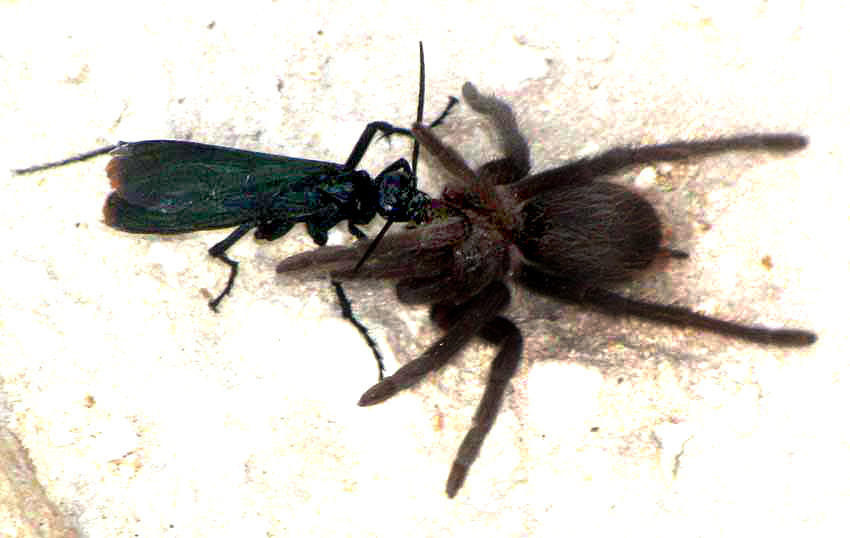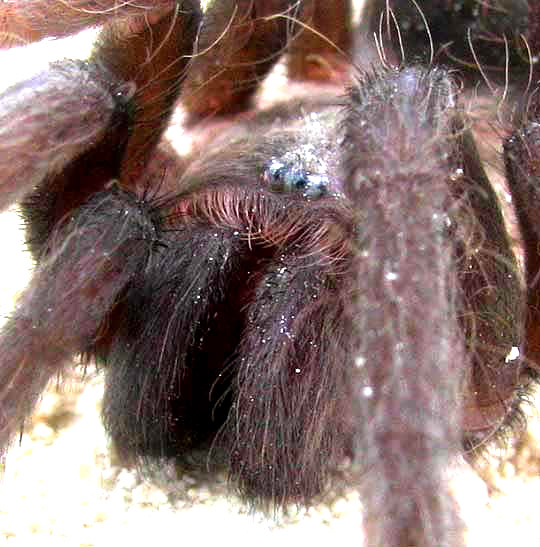Excerpts from Jim Conrad's
Naturalist Newsletter
from the August 17, 2007 Newsletter issued from Sierra Gorda Biosphere Reserve, QUERÉTARO, MÉXICO
A MEXICAN REDRUMP TARANTULA
Afew days ago as I approached my casita after a morning of teaching Silvestre called to me not to overlook the jar on my step holding the tarantula seen below:

That's BRACHYPELMA VAGANS*, sometimes called the Mexican Redrump Tarantula, even though it also extends south into Belize, Guatemala and El Salvador.
Tarantulas are docile and slow-moving, and don't bite unless obliged to. I've read that they "kick urticating hairs," urticating hairs being hairs that sting like nettle spines, so that's irritating but not serious.
When tarantulas "kick hairs" they dislodge urticating hairs from their abdomens and shower them at enemies, like sprays of stinging darts. This is a behavior evolved only among New World tarantulas, though not all New World tarantulas do it.
The individual in the picture is only partially grown. This species can have a leg span of five inches. The one shown is only about 3.5 inches. Males are typically smaller and thinner than females.
Like most tarantulas, Mexican Redrumps eat just about anything they can overpower, which is usually insects, but also small lizards and even rodents. Another student -- another Lupita since that's diminutive of the name Guadalupe, and many Mexican females are named after the Virgin de Guadalupe -- keeps a much larger Redrump as a pet, whom she feeds small toads and frogs.

from the September 25, 2011 Newsletter issued from Mayan Beach Garden Inn 20 kms north of Mahahual; Caribbean coastal beach and mangroves, ~N18.89°, ~W87.64°; Quintana Roo state, MÉXICO
TARANTULA HAWK WASP
On the white sand road late the other afternoon when everything already was in shadow, I came upon a very large wasp pulling a tarantula across the road, shown above. We've all seen wasps carrying spiders to their nests but this was my first tarantula. Suddenly the wasp left the tarantula in the middle of the road, and while it wandered around checking things where I got the nice close-up of the tarantula's "face" below:

As soon as I withdrew from the tarantula, the wasp returned and continued pulling her prey across the road.
A tarantula expert I correspond with tells me that probably the tarantula in our picture is an immature BRACHYPELMA [TLILTOCATL] VAGANS, or at least something currently called B. vagans because no-one knows what else to call it. If that's so, thus one is different from the poorly known and relatively small tarantula species we've seen up at Chichén Itzá, the Yucatan Redrump, Brachypelma epicureanum.
It took volunteer identifier Bea in Ontario to direct me to a group of wasps known as tarantula hawks, who do drag tarantulas around. The group incorporates two genera, Pepsis and Hemipepsis. Because of our wasp's large size I'm guessing it's a Pepsis.
In the 2006 book The Maya tropical forest: people, parks, & ancient cities by James D. Nations I read that female tarantula hawk wasps find their tarantulas by flying about using their sense of smell, looking for female tarantulas in their burrows or males in the open. If a female is found she's dragged from her burrow, stung and paralyzed, and then returned into her burrow where a single egg is laid on (not inside of) her abdomen. Then her burrow is sealed. If a male tarantula is encountered he's stung, the wasp digs a narrow burrow, drags the paralyzed male into it, and lays an egg on him.
When the egg hatches, the wasp grub sucks the comatose tarantula's body fluids. Once the grub is large enough it tears open the tarantula's body, and eats remaining goodies. The tarantula remains alive during most of its being eaten because the grub eats vital organs last of all. In the end, only the tarantula's "husk," or exoskeleton, is left. Then the larva pupates and digs its way out of the burrow, flies away, and begins the whole process over.